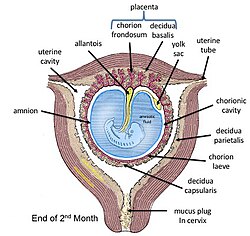
Back سقاء (أجنة) Arabic Allantois Azerbaijani Alantois BS Membrana al·lantoide Catalan Alantois Czech Allantois German Alantoides Spanish Allantois Estonian Alantoide Basque Allantoïde French
| Allantois | |
|---|---|
 Diagram illustrating a chicken egg in its 9th day with all extraembryonic membranes | |
 Allantois and other fetal membranes shown at end of second month of human pregnancy | |
| Details | |
| Pronunciation | /əˈlæntɔɪs/, /əˈlæntoʊɪs/ |
| Days | 16 |
| Identifiers | |
| Latin | allantois |
| MeSH | D000482 |
| TE | E6.0.1.2.0.0.2 |
| Anatomical terminology | |
The allantois (/əˈlæntoʊɪs/ a-LAN-toe-iss;[1] pl.: allantoides or allantoises) is one the extraembryonic membranes arising from the yolk sac. It is a hollow sac-like structure filled with clear fluid that forms part of the developing conceptus in an amniote that helps the embryo exchange gases and handle liquid waste. The other extraembryonoic membranes are the yolk sac, the amnion, and the chorion. In mammals these membranes are known as fetal membranes.
The allantois, along with the amnion, chorion, and yolk sac (other extraembryonic membranes), identify humans and other mammals, birds, and reptiles as amniotes. These extraembryonic membranes that form the embryo have aided amniotes in the transition from aquatic to terrestrial environments.[2] Fish and amphibians are anamniotes, lacking the allantois.
- ^ Jones, Daniel (October 6, 2011). Cambridge English Pronouncing Dictionary. Cambridge University Press. ISBN 9780521765756 – via Google Books.
- ^ Chuva de Sousa Lopes, Susana M.; Roelen, Bernard A. J.; Lawson, Kirstie A.; Zwijsen, An (2022-12-05). "The development of the amnion in mice and other amniotes". Philosophical Transactions of the Royal Society B: Biological Sciences. 377 (1865): 20210258. doi:10.1098/rstb.2021.0258. ISSN 0962-8436. PMC 9574641. PMID 36252226.